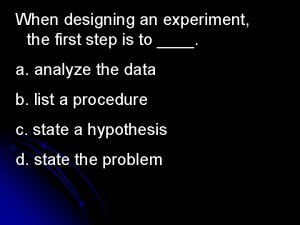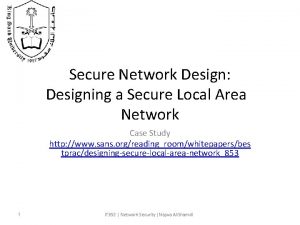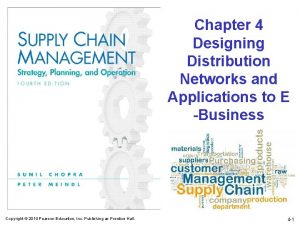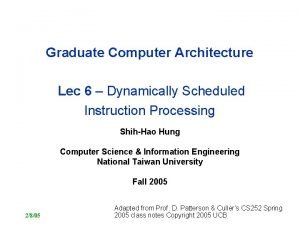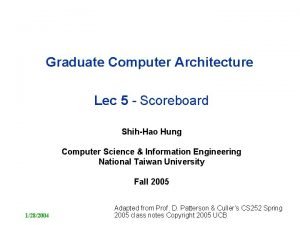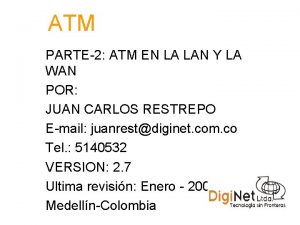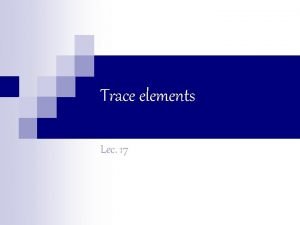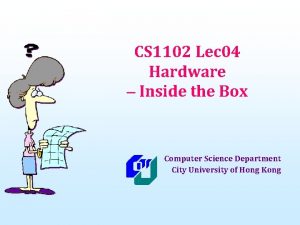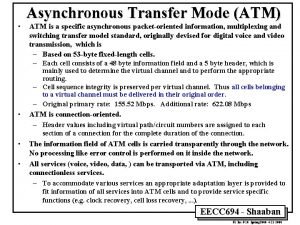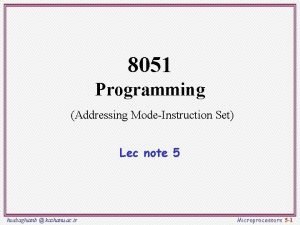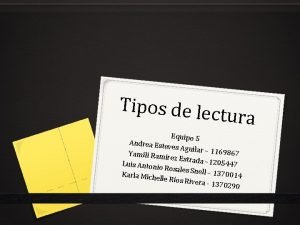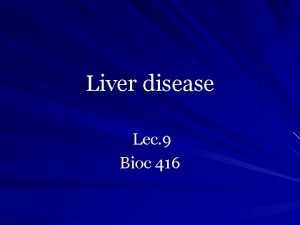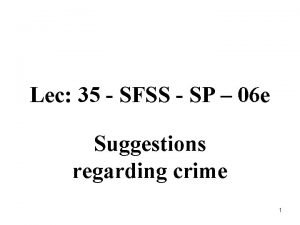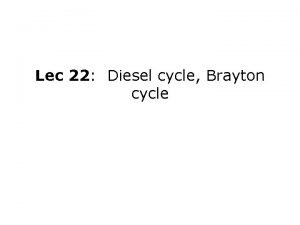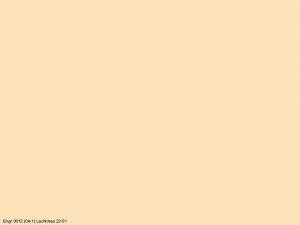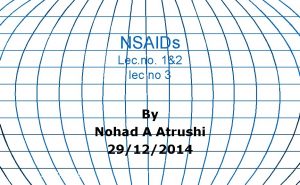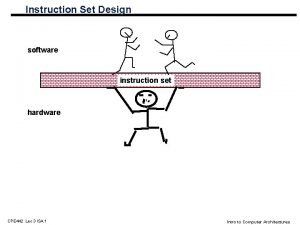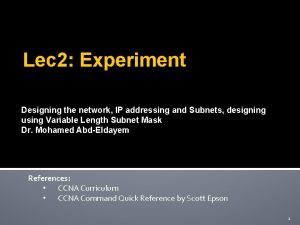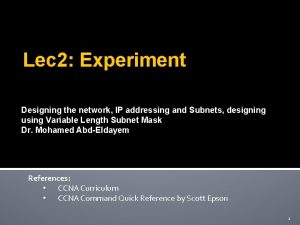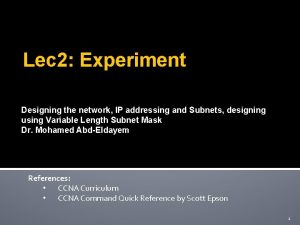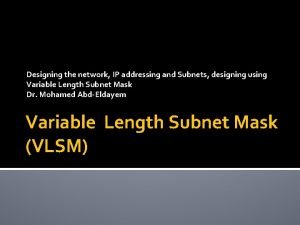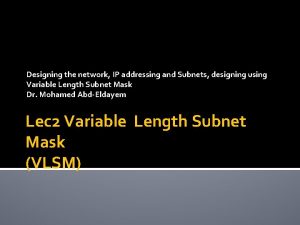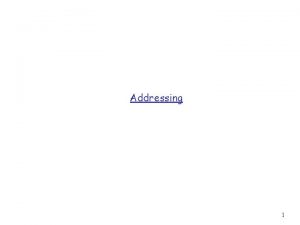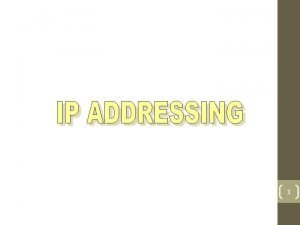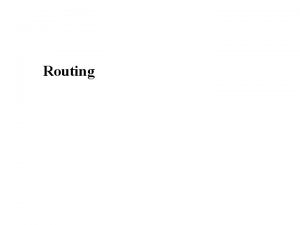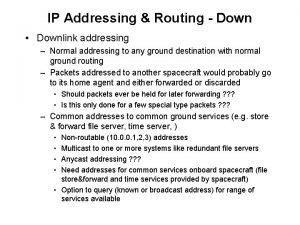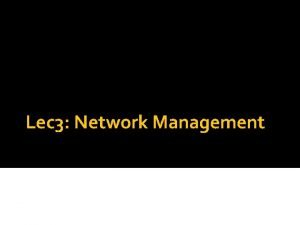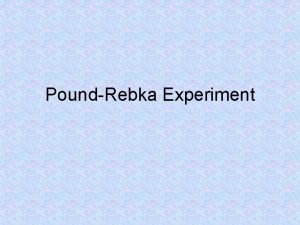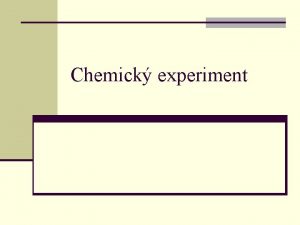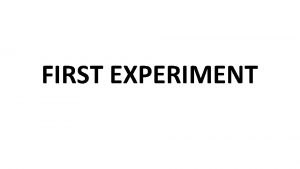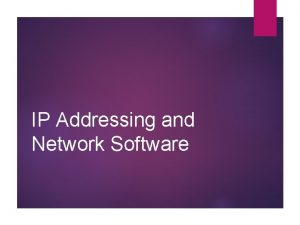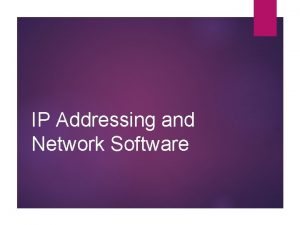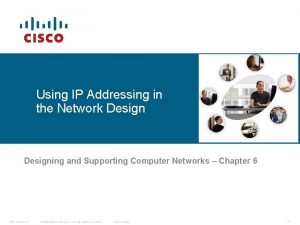Lec 1 Experiment Designing the network IP addressing

















































- Slides: 49

Lec 1: Experiment Designing the network, IP addressing and Subnets, designing using Variable Length Subnet Mask Dr. Mohamed Abd-Eldayem References: • CCNA Curriculum • CCNA Command Quick Reference by Scott Epson 1

Network Devices Comparison Bridge L 3 Switch - Router Work on Layer 2 (Data Link Layer) of the OSI model Work on Layer 3 (Network Layer) of the OSI model Uses the MAC address (physical address) to locate devices in the network Uses the IP address (Logical Address) for locating devices in the network. Connect two similar network segments together Connects multiple network segments together Waste the bandwidth of the network because it broadcast messages Saves the bandwidth of the network because it establishes a direct link between the source and the destination address 2

IP address VS. MAC address IP address • Is a (physical address) that is written on the network card of devices (permanent address). • Is a 32 -bit (logical address) that is assigned to devices attached to the network by network devices such as switch. • Used in layer 3 (Network Layer) of the OSI model • Used in layer 2 (Data Link Layer) of the OSI model 3

2. 1 Ethernet Switching 2. 1 Layer 2 bridging 00000 CBBBBBB 4

2. 1 Layer 2 bridging (A -> B) � The bridge has just been started so the bridge table is empty. � The bridge just waits for traffic on the segment. When traffic is detected, it is processed by the bridge. Bridge Table MAC Address 1. Port Host A is pinging Host B. Data is transmitted on the entire collision domain (segment 1), both the bridge and Host B process the packet. 5

2. 1 Layer 2 bridging (A -> B) 2. The bridge adds the source address of the frame (Host A) to its bridge table. Since the frame was received on port 1, the frame must be associated with port 1 in the table. Bridge Table 3. MAC Address Port 00000 CAAAAAA Port 1 The destination address of the frame is checked against the bridge table. Since the address is not in the table, the frame is forwarded to the other segment (Segment 2). 6

2. 1 Layer 2 bridging (A -> B) 4. Host C & D discards the received frame as they were not the intended destination. 5. Host B processes the ping request and transmits a ping reply back to Host A. The data is transmitted over the whole collision domain. Both Host A and the bridge receive the frame and process it. 6. The bridge Adds the source address of the replay frame to its bridge table (Host B). Bridge Table MAC Address Port 00000 CAAAAAA Port 1 00000 CBBBBBB Port 1 Check the destination address of the frame against the bridge table. Since the address is found in the table at port 1 the frame is not forwarded. 7

2. 1 Layer 2 bridging (A -> C) Host A ping Host C. 1. the frame is transmitted on the entire collision domain (segment 1) Both the bridge and Host B process the frame. Host B discards the frame as it was not the intended destination. 2. The Bridge renew the source address of the frame (Host A) in the bridge table because it is already entered. 3. The destination address of the frame (Host C) is checked against the bridge. Since the address is not in the table, the frame is forwarded to the other segment (Segment 2) 8

2. 1 Layer 2 bridging (A -> C) 3. Host C processes the ping request and transmits a ping reply back to Host A. The data is transmitted over the whole collision domain (Segment 2). 4. Host D discards the frame, as it was not the intended destination. 9

2. 1 Layer 2 bridging (A -> C) 5. The bridge adds the source address of the frame (Host C) to its bridge table. The frame must be associated with port 2 in the table. Bridge Table 6. MAC Address Port 00000 CAAAAAA Port 1 00000 CBBBBBB Port 1 00000 CCCCCCC Port 2 The destination address of the frame (Host A) is checked against the bridge. The address is in the table but it is associated with port 1, so the frame is forwarded to the other segment (Segment 1). 10

• A bridge has only two ports and divides a collision domain into two parts, but it do not affect the logical or Layer 3 addressing. Thus, a bridge will divide a collision domain but has no effect on a logical or broadcast domain. 11

2. 2 Switch operation • A switch is simply a bridge with many ports. When only one node (computer) is connected to a switch port, the collision domain on the shared media contains only two nodes. • Most switches are capable of supporting full duplex (means that data can be transmitted in both directions on the medium at the same time) 12

Revision: Converting Decimal To Binary Example convert the decimal number 198 to binary number? Decimal: 198 Binary: 11000110 The binary number is the reminder written from the bottom to the top Reminder Divisor Decimal Number 0 2 198 1 2 99 1 2 49 0 2 24 0 2 12 0 2 6 1 2 3 1 2 1 0 13

Revision: Converting Binary To Decimal Converting the binary number 11000110 to decimal number 1 1 x 27 128 + 1 0 0 0 1 1 0 + 1 x 2 6 + 0 x 2 5 + 0 x 24 + 0 x 2 3 + 1 x 2 2 + 1 x 2 1 + 0 x 2 0 64 + Decimal 0 + Number 0 + 4 + 2 + 0 = 198 14

IP Address � An IP address is four bytes (octets). Each contains eight bits (total of 32 bits in length). � Each octet is a number from 1 to 254. � IP addresses are usually given as dotted decimal notation. 15

Class A, B, C, D, and E IP addresses � IP addresses are divided into five classes: Class A addresses are assigned to larger networks. Class B addresses are used for medium-sized networks. Class C for small networks. Class D used by multicast group. Class E reserved by research groups Each class uses a different combination of octets to indicate the number of the network and the number of the host. � The first step in determining which part of the address identifies the network and which part identifies the host is identifying the class of an IP address. 16

IP Classes � Class A � Class B � Class C 17

2. 4 Reserved IP addresses: Ø Network address – Used to identify the network itself An IP address that has binary 0 s in all host bit positions is reserved for the network address. Ex. : The 198. 150. 11. 0 network. ▪ Data that is sent to any host on that network (ex: hosts number 198. 150. 11. 1 - 198. 150. 11. 254) will be seen outside of the local area network as 198. 159. 11. 0. ▪ The only time that the host numbers matter is when the data is on the local area network. Ø Broadcast address – Used for broadcasting packets to all the devices on a network The 198. 150. 11. 255 broadcast address. Data that is sent to the broadcast address will be read by all hosts on that network (198. 150. 11. 1 - 198. 150. 11. 254). 18

Host & Network Portions for the different classes Class First octet Example Network Part Host part xxx 126 (23*23*23)-2 = 16777214 xxx 16, 384 (23*23)-2 = 65, 534 xxx 2 million (23)-2 = 254 12. 240. 60. 89 • A 1 -126 127. 8. 90. 2 • 130. 240. 60. 89 • B 128 -191 191. 8. 90. 2 • 192. 240. 60. 89 • C 192 -223 223. 8. 90. 2 • Number of Hosts * Number of Networks • The first address ( xxx. 0) & the last address (xxx. 111) are reserved for the network • ( xxx. 0) for the network & (xxx. 111) for broadcasting 19

Unicast Broadcast Multicast Unicast packets are sent from single host to another single host. Broadcast is when a single device is transmitting a message to all other devices in a given address range. Multicast enables a single device to communicate with a specific set of hosts, not defined by any standard IP address and mask combination. There is one device transmitting a message destined for one receiver. This broadcast could reach all hosts on the subnet, all subnets, or all hosts on all subnets. Broadcast packets have the host (and/or subnet) portion of the address set to all ones. Communication resembles a conference call. Anyone from anywhere can join the conference, and everyone at the conference hears what the speaker has to say. The speaker's message isn't broadcasted everywhere, but only to those in the conference call itself. 20

Example 1 Network Address: 72. 0. 0. 0 What is the Network address? 72. 0. 0. 0 To which class this network belongs? Class A because network number = 72 72 ϵ {1 -126} What is the broadcast address? Host 2: 72. 167. 98. 70 Host 1: 72. 167. 98. 77 Host 4: 72. 167. 98. 71 Host 3: 72. 167. 98. 75 72. 255 What is the IP addresses of the hosts? • IP Address of host 1: 72. 167. 98. 77 • IP Address of host 2: 72. 167. 98. 70 • IP Address of host 3: 72. 167. 98. 75 • IP Address of host 4: 72. 167. 98. 71 LAN 21

What is subnetting? � Subnetting is the process of borrowing bits from the HOST bits, in order to divide the larger network into small subnets. � Subnetting does NOT give you more hosts, but actually costs you hosts (decrease number of hosts). � You lose two host IP Addresses for each subnet, and perhaps one for the subnet IP address and one for the subnet broadcast IP address. 22

Why Do We Use Subnetting? A company uses two or more types of LAN technology (for example, Ethernet, Token Ring) on their network or different physical media (such as Ethernet, FDDI, WAN, etc. ) � Two network segments are restricted by distance limitations (for example, remote offices linked via point-topoint circuit). � Segments need to be localized for network management reasons (accounting segment, sales segment, etc. ). � Hosts which dominate most of the LAN bandwidth need to be isolated. � Security. � The most common reason is to control network traffic. � 23

How it works? �The IP address is split into a network and host portion. �The network portion always remains fixed for a particular network, while the remaining bits which make up the host portion can be altered to give the range of addresses to assign to hosts. �To determine where the network portion ends and the host portion begins, a subnet mask is used. 24

Subnet Mask �A subnet mask is used to separate a network number from the host number in an IP address. � 255 represents a network and 0 represents a host. � Default subnet masks: Class A - 255. 0. 0. 0 - 1111. 00000000 Class B - 255. 0. 0 - 11111111. 0000 Class C - 255. 0 - 11111111. 0000 5/22/2021 Fatimah Al-Akeel - Network 9 25

Steps to Solve Subnetting Questions Look at the MSB (Most Significant Bit) of the IP, Identify the Class(A, B or C), then determine the number of bits assigned to the Network Portion (8 for class A, 16 for Class B and 24 for Class C) Ex. : IP=182. 250. 200. 3, Class = B, N =16 bits 1) Look at Subnet Mask (SM), the number of zeros identify the Host portion Ex. SM = 11111111. 0000, H=8 bits 2) Look at IP and SM together, The portion Between the Network and Host portions is the Sub Network portion. 1) Ex. IP= 182. 250. 200. 3 10110110. 11111010. 11001000. 00000011 SM = 11111111. 0000 = 255. 0 N = 16 SN = 8 H= 8 26

Steps to Solve Subnetting Questions Identify the Subnet ID: By doing (IP address ) AND (Mask) 4) Subnet ID = 10110110. 11111010. 11001000. 0000 Identify Broadcast address: By changing all bits of host portion in Subnet ID to 1’s. 5) Broadcast address = 10110110. 11111010. 11001000. 1111 Identify the First IP address: Change the LSB of host portion in Subnet ID to 1. 6) First IP address = 10110110. 11111010. 11001000. 00000001 Identify the Last IP address: Subtract 1 from host portion of Broadcast address. 7) Last IP address = 10110110. 11111010. 11001000. 11111110 27

Example (1) � Given the following IP address 38. 9. 211. 19 with a subnet mask of 255. 240 determine: 1. Network Address 2. Default subnet mask 3. Broadcast address of the network 4. Subnet ID 5. Broadcast address of the subnet. 6. First & last host address in the subnet. 28

Example (1) 1. Network Address ▪ To determine the network address we have to determine the class of the IP address ▪ 38. 9. 211. 0 38 ϵ {1 -126} Class A In class A network portion is the first octet & the remaining three octets for the host are zeros. Network Address: 38. 0. 0. 0 29

Example (1) 2. Default subnet mask For Class A addresses, default subnet mask is: 255. 0. 0. 0 3. Broadcast address of the network Changing all the host bits to 1 give you the broad cast address: Broadcast Address = 38. 255 30

Example (1) Subnet ID: 4. First: Determine the following bits in the following order: ▪ ▪ Network portion (N) (Fixed depends on the IP class) Subnet portion (S) (From the end of the network portion to the last bit in the mask with the value 1) Host portion (H) (The remaining bits after the subnet portion) N=8 S = 20 H=4 IP 00100110. 00001001. 11010011. 00010011 Mask 11111111. 11110000 31

Example (1) Second: Do the AND operation between the IP address & the mask � IP Mask 00100110. 00001001. 11010011. 00010011 AND 11111111. 11110000 _______________________ Subnet ID 00100110. 00001001. 11010011. 00010000 Subnet ID in decimal = 38. 9. 211. 16 32

Example (1) 5. Broadcast address of the subnet. To get the broad cast address replace the host bits in the subnet ID with 1 s Host bits Subnet ID 00100110. 00001001. 11010011. 00010000 Broadcast Address 00100110. 00001001. 11010011. 00011111 Broadcast Address in decimal 38. 9. 211. 31 33

Example (1) 6. First & last host address in the subnet. To get the first address replace all the host bits with zeros except the last bit replace it with one as follows: Host bits Subnet ID 00100110. 00001001. 11010011. 00010000 Host bits First Host Address 00100110. 00001001. 11010011. 0001 First Host Address in decimal 38. 9. 211. 17 34

Example (1) 6. First & last host address in the subnet. To get the last address replace all the host bits with ones except the last bit replace it with zero as follows: Host bits Subnet ID 00100110. 00001001. 11010011. 00010000 Host bits Last Host Address 00100110. 00001001. 11010011. 00011110 Last Host Address in decimal 38. 9. 211. 30 35

Example (2): IP=182. 250. 200. 028, SM= 255. 248 IP = 10110110. 11111010. 11001000. 00011100 SM = 11111111. 11111000 N = 16 SN = 13 H= 3 Class of the IP is B Network Address= 10110110. 11111010. 00000000 Default Subnet Mask of the IP = 11111111. 0000 Broadcast address of the network = 10110110. 11111010. 11111111 Subnet ID Broadcast address of the subnet = 10110110. 11111010. 11001000. 00011111 First IP address = 10110110. 11111010. 11001000. 00011001 Last IP address = 10110110. 11111010. 11001000. 00011110 = 10110110. 11111010. 11001000. 00011000 36

In Decimal Example (2): IP=182. 250. 200. 28, SM= 255. 248 IP = 182. 250. 200. 28 SM = 255. 248 Class of the IP is B Network Address= 182. 250. 0. 0 Default Subnet Mask of the IP = 255. 0. 0 Broadcast address of the network = 182. 250. 255 Subnet ID Broadcast address of the subnet = 182. 250. 200. 31 First IP address = 182. 250. 200. 025 Last IP address = 182. 250. 200. 030 = 182. 250. 200. 024 37

Demonstrating the different type of IPs in Example (2) Subnet ID: 182. 250. 200. 024 First IP: 182. 250. 200. 025 Last IP: 182. 250. 200. 030 Network Address: 182. 250. 0. 0 38

Public and private IP addresses � Public IP addresses are unique and it must be obtained from an Internet service provider (ISP) � RFC 1918 sets aside three blocks of IP addresses for private, internal use. These three blocks consist of one Class A, a range of Class B addresses, and a range of Class C addresses. Addresses that fall within these ranges are not routed on the Internet backbone. Internet routers immediately discard private addresses. 39

Public and private IP addresses � If addressing a nonpublic intranet, a test lab, or a home network, private addresses can be used instead of globally unique addresses. � Connecting a network using private addresses to the Internet requires translation of the private addresses to public addresses. This translation process is referred to as Network Address Translation (NAT). 40

41

• For any IP address, if the subnet mask is the default IP address of that class then there is no subnetting 42

Establishing the subnet mask address � Selecting the number of bits to use in the subnet process will depend on the maximum number of hosts required per subnet. Most Significant Bit (MSB) Least Significant Bit (LSB) � The last two bits in the last octet, regardless of the IP address class, may never be assigned to the subnetwork. � The subnet mask gives the router the information required to determine in which network and subnet a particular host resides. 43

Establishing the subnet mask address � If three bits were borrowed, the mask for a Class C address would be 255. 224. � This mask may also be represented, in the slash format, as /27. The number following the slash is the total number of bits that were used for the network and subnetwork portion � To determine the number of bits to be used, the network designer needs to calculate how many hosts the largest subnetwork requires and the number of subnetworks needed. 44

Subnetting chart 45

Ex 1. : A network requires 30 hosts and five subnetworks. IP = 192. 168. 10. 0, Class C � Using the subnetting chart, by consulting the row titled ”Usable hosts”, the chart indicates that for 30 usable hosts three bits are required. This creates, six usable subnetworks. � Number of usable subnets= two to the power of the assigned subnet bits or borrowed bits, minus two (reserved addresses for subnetwork id and subnetwork broadcast) usable subnets =(2 � borrowed bits) – 2 = (23) – 2 = 6 Number of usable hosts= two to the power of the bits remaining, minus two (reserved addresses for subnet id and subnet broadcast) usable hosts= (2 remaining host bits) – 2 = (25) – 2 = 30 46

Ex 1. : A network requires 30 hosts and five subnetworks. IP = 192. 168. 10. 0, Class C 47

Subnetting Class A and B networks � The available bits for assignment to the subnet field in a Class A address is 22 bits while a Class B address has 14 bits. � Assigning 12 bits of a Class B address to the subnet field creates a subnet mask of 255. 240 or /28. � Assigning 20 bits of a Class A address to the subnet field creates a subnet mask of 255. 240 or /28. � class of address needs to be subnetted: Total subnets = 2 the bits borrowed Total hosts= 2 the bits remaining Usable subnets = 2 the bits borrowed - 2 Usable hosts= 2 the bits remaining - 2 48

49
 Flat addressing vs hierarchical addressing
Flat addressing vs hierarchical addressing First step in designing an experiment
First step in designing an experiment How to secure a local area network
How to secure a local area network Factors influencing distribution network design
Factors influencing distribution network design Lec scoreboard
Lec scoreboard 11th chemistry thermodynamics lec 13
11th chemistry thermodynamics lec 13 Lec ditto
Lec ditto Lec scoreboard
Lec scoreboard Componentes del lec
Componentes del lec 11th chemistry thermodynamics lec 10
11th chemistry thermodynamics lec 10 Lec element
Lec element August lec 250
August lec 250 Underground pipeline for irrigation
Underground pipeline for irrigation Lec 1
Lec 1 Apelacin
Apelacin Lec
Lec 132000 lec
132000 lec Lec@b@ret
Lec@b@ret Tura analítica
Tura analítica Sekisui slec
Sekisui slec 416 lec
416 lec Lec
Lec Brayton
Brayton Lec promotion
Lec promotion Lec anatomia
Lec anatomia History of software development life cycle
History of software development life cycle Fenemates
Fenemates Lecsl
Lecsl Lec hardver
Lec hardver Lec renal
Lec renal 252 lec
252 lec Hình ảnh bộ gõ cơ thể búng tay
Hình ảnh bộ gõ cơ thể búng tay Bổ thể
Bổ thể Tỉ lệ cơ thể trẻ em
Tỉ lệ cơ thể trẻ em Voi kéo gỗ như thế nào
Voi kéo gỗ như thế nào Chụp tư thế worms-breton
Chụp tư thế worms-breton Bài hát chúa yêu trần thế alleluia
Bài hát chúa yêu trần thế alleluia Môn thể thao bắt đầu bằng chữ f
Môn thể thao bắt đầu bằng chữ f Thế nào là hệ số cao nhất
Thế nào là hệ số cao nhất Các châu lục và đại dương trên thế giới
Các châu lục và đại dương trên thế giới Công của trọng lực
Công của trọng lực Trời xanh đây là của chúng ta thể thơ
Trời xanh đây là của chúng ta thể thơ Mật thư tọa độ 5x5
Mật thư tọa độ 5x5 101012 bằng
101012 bằng độ dài liên kết
độ dài liên kết Các châu lục và đại dương trên thế giới
Các châu lục và đại dương trên thế giới Thơ thất ngôn tứ tuyệt đường luật
Thơ thất ngôn tứ tuyệt đường luật Quá trình desamine hóa có thể tạo ra
Quá trình desamine hóa có thể tạo ra Một số thể thơ truyền thống
Một số thể thơ truyền thống

